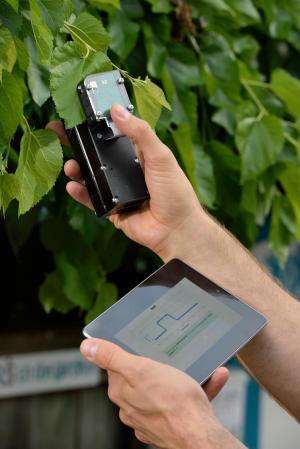David Kramer, MSU Hannah Distinguished Professor in Photosynthesis and Bioenergetics, has created the Facebook of plant science. Credit: MSU
By building PhotosynQ - a handheld device with sensors and an online data-sharing and analysis platform - a team of Michigan State University researchers is creating the plant-science equivalent of Facebook.
Following the trail blazed by successful social media networks, the team is giving away patentable devices at a nominal fee, building an active global community of plant science enthusiasts and sharing all data collected from around the world.
The goal is to allow even citizen scientists to make research-quality measurements, said David Kramer, MSU Hannah Distinguished Professor in Photosynthesis and Bioenergetics.
"We've built a platform that everyone can access through their cell phones," he said. "We want to create a community that sees a 12-year-old student in China ask a question about a drought-resistant plant. Then we hope that hundreds of people answer, and not only the student in China is able to grow sustainable crops, but also a farmer in Africa could benefit from those insights."
One component of PhotosynQ is a handheld device that costs about $100, scans plants and collects a handful of key data points. Via a smartphone running Android, the data is transferred from the device to the researcher's project page on the PhotosynQ platform.
Currently, there are about 20 research projects on the burgeoning network. As new data is collected, community members can observe the projects' progression.
Projects range from one measuring the robustness and productivity of beans, to another monitoring the efficiency of photosynthesis. Collecting data on how well plants convert sunlight to energy can be derived from satellite images in a very limited way. To improve the data, it's best to get on-the-ground observations as well. The more handheld devices used in the field to gather the data, the better.
PhotosynQ will enable local scientists, plant breeders and citizens to improve the productivity and security of crops in communities around the world. This low-cost approach of collecting samples from global sites could change how science has traditionally been conducted, said Greg Austic, who is leading the development in the Kramer lab.
"It's critical that PhotosynQ stays open source," he said. "We're changing the model of moving new technology from academia to the world. We're maximizing the data and building a community rather than maximizing profits."
If only two people use the network, it's worthless. If 2 million people join in, it's priceless. It will be a snapshot of what's happening in the plant world at this very moment. Successful breeding efforts, rapidly spreading diseases and other trends can be identified quicker, he added.
This nontraditional approach is indicative of Kramer's unique lab. Soldering irons and circuit boards outnumber plants and petri dishes. Shelves are lined with electronic prototypes. The buzzing hive of nearly 40 students is a blend of biologists, programmers and engineers.
"Many times one of our biology students will come up with an idea and bounces it off some of the other students," Kramer said. "The computer specialists write a program, and the electronics students build a prototype and a new technique is developed and used - sometimes in a single day."
His lab is a microcosm of what he hopes he can create on a global scale; empower people with data and easy-to-use scientific instruments, and people will look at their world differently, he said.
Provided by Michigan State University






















